Wellfleet Bay is blessed with a healthy, replicating population of Eastern Box Turtles (Terrapene carolina carolina), a species of special concern in Massachusetts. We study our population closely from spring until fall, but we haven’t spent much time monitoring them during brumation, which is the hibernation-like state that cold-blooded animals utilize in very cold weather. This past winter, I decided to follow a couple of turtles through the entire process and document what happens.
Brumation and hibernation are closely related and are typified by periods of inactivity during which an animal slows down its metabolic processes and stops growing. Both brumation and hibernation are triggered by cues such as day length, humidity, temperature and barometric pressure.
The primary difference is that in a true hibernating animal like a groundhog, the animal is actually asleep. While an animal that brumates, like a box turtle, is still conscious although in a state of dormancy. Brumation is also thought to reset the biological clock in reptiles, triggering sperm production in males and preparing females for ovulation in the spring. Brumation also puts extreme stress on an animal and older or physically compromised individuals may perish during brumation if conditions become too harsh.
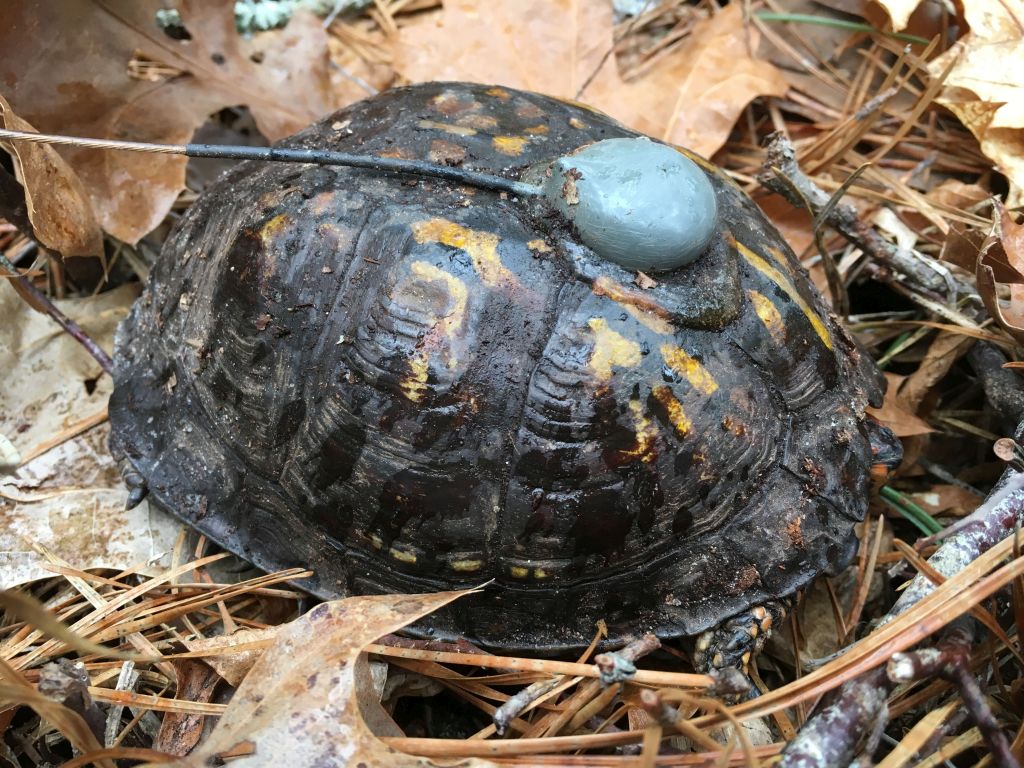
Turtle number 348 has a radio tag on his shell which emits a signal that allows him to be located and tracked. (Photo by Tim O’Brien)
Because box turtles often return to the same brumation sites year after year, it’s relatively easy to locate them. I also had the added benefit of an animal with a radio tag (turtle #348) making it easier to follow.
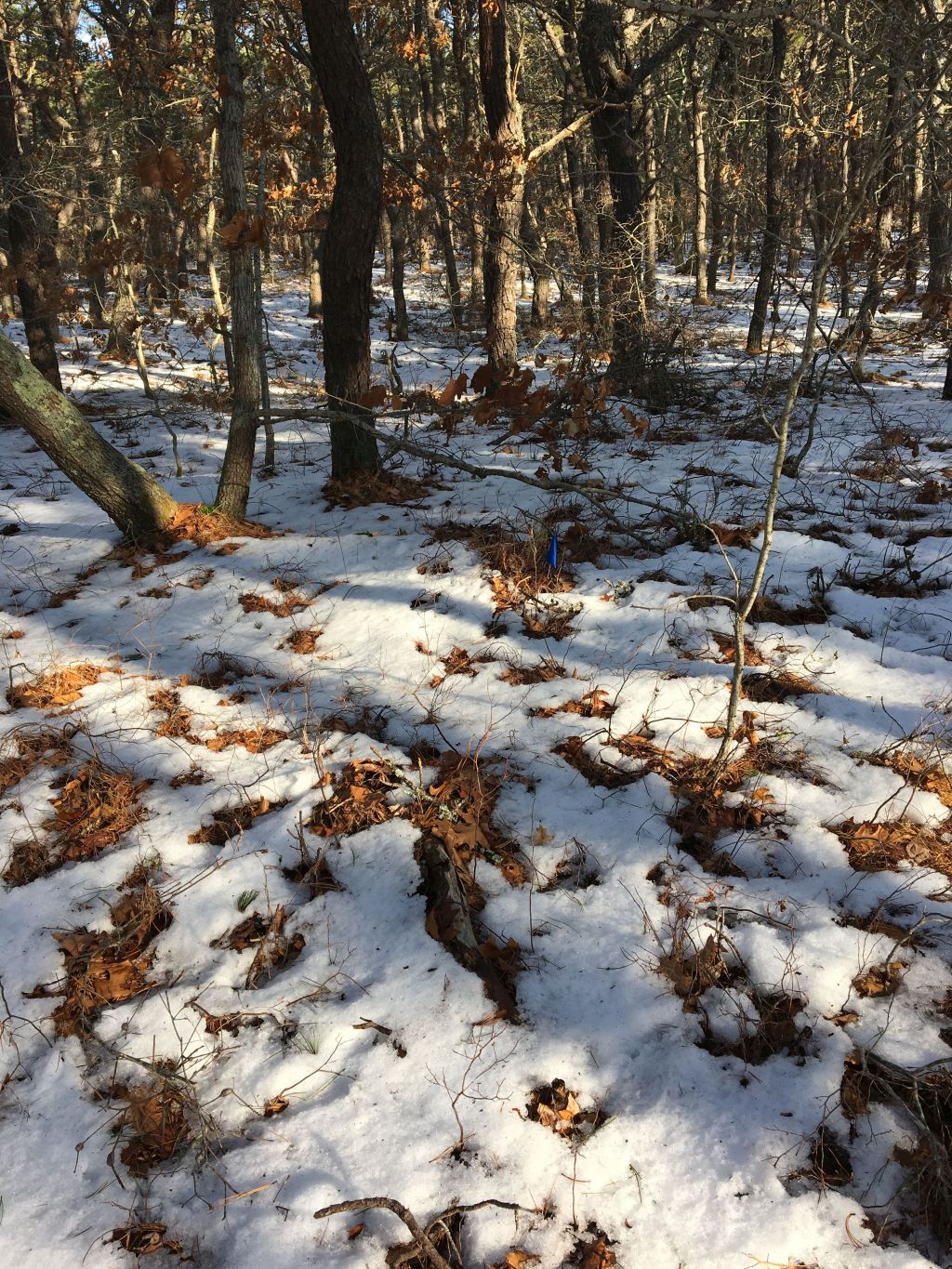
The neighborhood of turtle 348’s brumation site. Spongy layers of dead leaves and pine needles allow for good burrow digging. (Photo by Tim O’Brien)
In November, I was able to observe two box turtles going into brumation, turtles #22 and #348. Both utilized separate brumation sites in wooded areas, typically south facing with soft detritus composed of decades of decomposing pine needles and the leaves of deciduous trees. This detritus is easy for the turtle to burrow into and holds moisture, which is important so that the turtles don’t dehydrate. And, finally, the substrate beneath the surface in these locations does not freeze, even in the dead of winter.
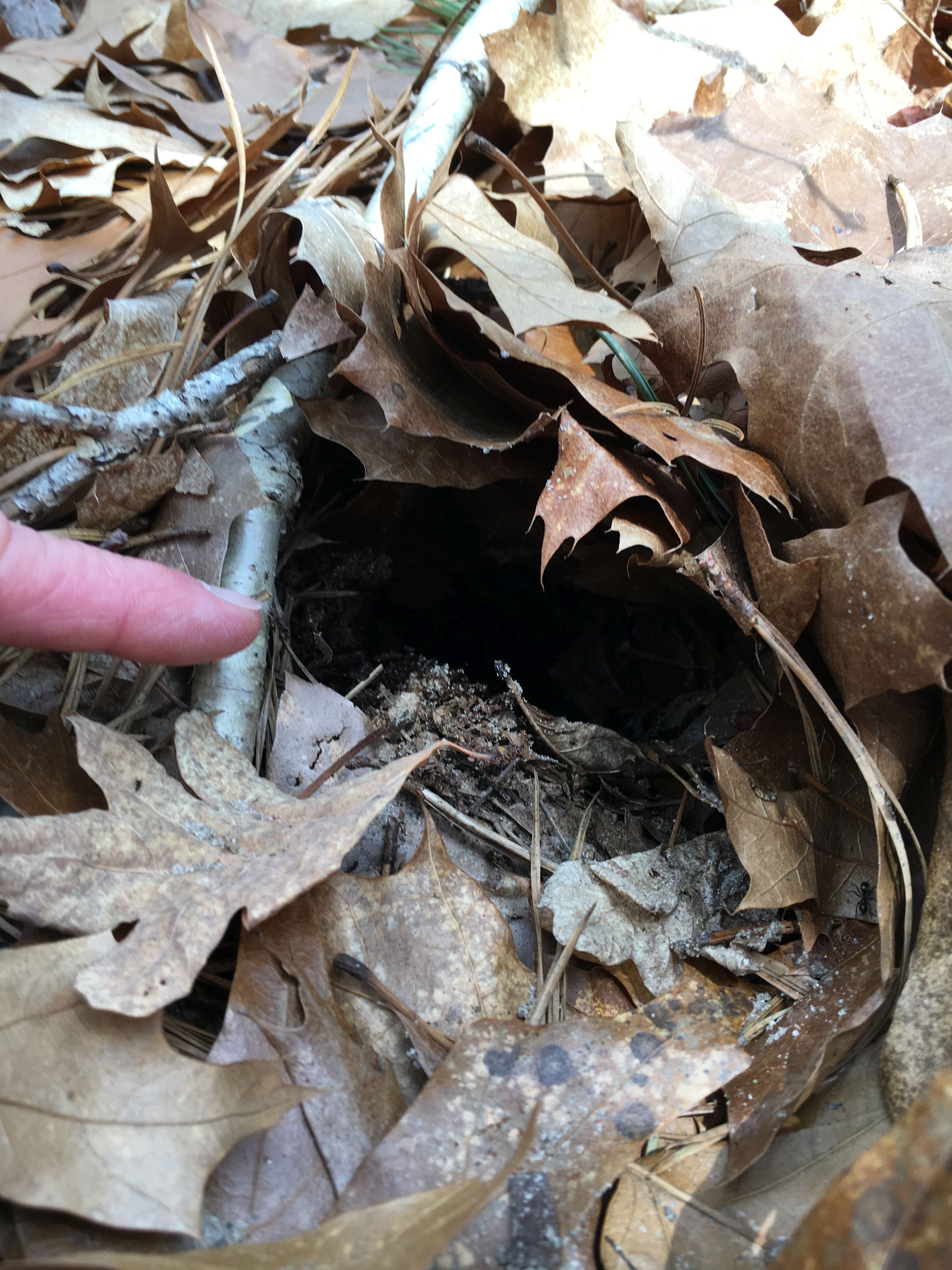
Turtle 22’s burrow entrance. (Photo by Tim O’Brien)
I monitored each turtle weekly until April. I measured the point at which the turtle rested within the burrow using a metric cloth ruler. Turtle #348 began his dig on November 4th.
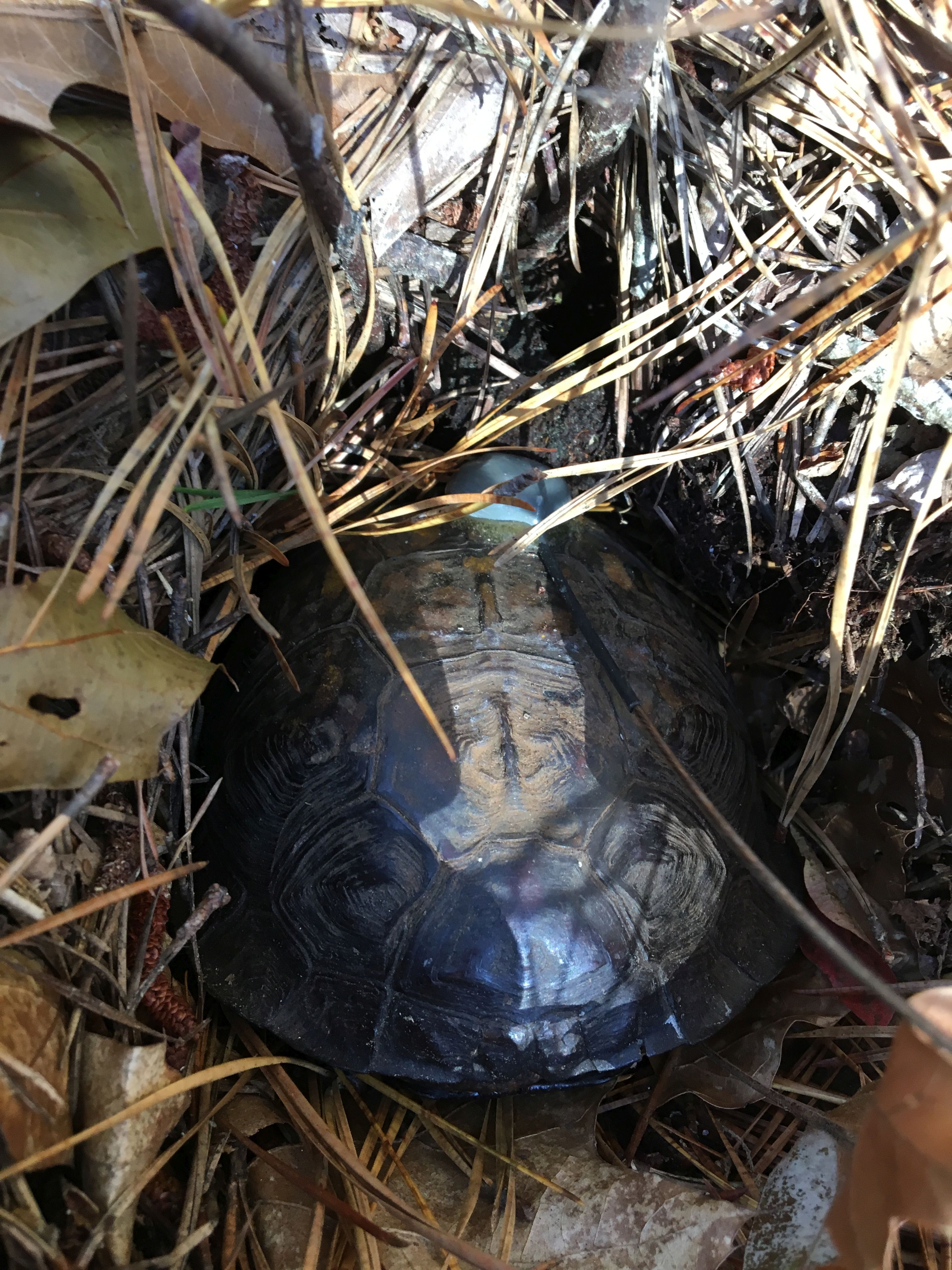
Turtle 348, estimated to be about 40 years old, begins to enter his brumation burrow last November. (Photo by Tim O’Brien)
Turtle #22 was found already in her burrow on November 21st. Both turtles initially settled in at the relatively shallow depth of 5 centimeters—a little less than 2 inches. At this point, you could see the turtle’s carapace simply by looking into the burrow. By the end of December turtle # 348 had moved down to 40cm—or about 16 inches deep. Interestingly, turtle 22 stayed at 5cm until mid-January, when she finally moved to what would be her maximum depth of 10cm. I noted one instance in which she had turned completely in her burrow in February. By late February she was back up to 5cm (perhaps triggered by unusually warm weather). But four weeks later, she was back to 10cm in depth. By mid-April she’d returned to 5cm and then she emerged, quite conveniently while I was there, on April 29th.
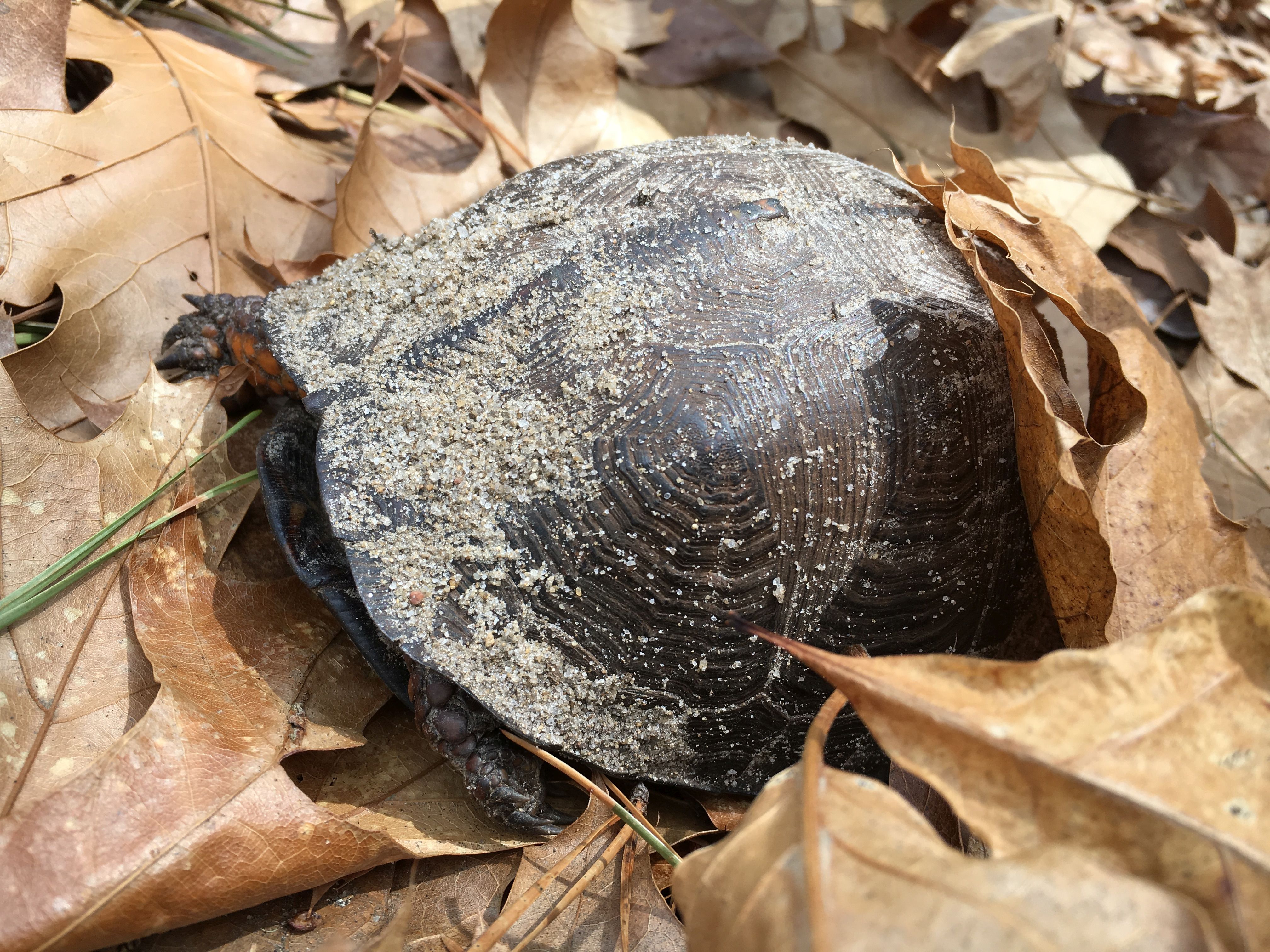
Turtle 22, who’s brumated for about 25 winters, welcomes spring…in a box turtle sort of way. (Photo by Tim O’Brien)
Turtle #348, did not exhibit quite so much movement within the burrow. After his initial entrance into the burrow, he rested at 5cm for a few weeks and then retreated to 40cm where he spent the entire winter with little movement noted. He emerged during the first week of May, specifically May7th. Both turtles appeared to be in good health.
During this study we learned that our box turtles enter into brumation during the early part of November and remain there until May. They change position and depths within their burrows as well, probably influenced by temperature. While turtle #348 brumated at a more typical depth, turtle #22 spent the entire winter at a depth no greater than 10cm. Why?
We hope to do a similar brumation study in the fall, this time studying the temperature and humidity within the burrows using a data logger designed for this purpose. This might help us understand how temperature and humidity may play a role in determining the depth at which a box turtle brumates.

Citizen scientist Tim O’Brien as he appears on many Sundays through the year tracking and monitoring EBTs. (Photo by Kim Novino)
This post was contributed by Wellfleet Bay volunteer and naturalist Tim O’Brien who’s been keeping tabs on Eastern Box Turtles at Wellfleet Bay for 30 years. He’s been monitoring them for the past 15 years.


I have done unofficial studies of the box turtles in my yard for five (or so) years now. I live in a neighborhood adjacent to a wooded lot in south-eastern Virginia. I would love to participate in more formal studies. How to you identify your turtles?
Hi Sally:
We use a modified version of the Cagle Marking System (1939). This involves putting a small notch on the edge of a specific marginal scute on the turtle’s carapace that corresponds to a number. Each scute has a different numerical value, so by notching one, two or three different scutes, we can assign each turtle any number that we want. I would think that if you only have a few turtles, photographs of the carapace and plastron of each individual should suffice to uniquely identify your study turtles. Good luck!
Tim
Good work, Tim!
Thanks for keeping a watchful eye on our shelled friends!!!
Thanks for keeping a watchful eye on our shelled friends!!!!!
Nice job!